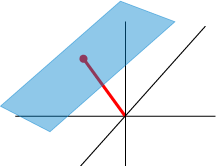Section4.3Week 9 (Jul 23-27)
Last week we were introduced to the concept of eigenvectors: vectors which, when a linear transformation acts upon them, are transformed simply into (scalar) multiples of their old selves. These are vectors that, for a given matrix \(A\text{,}\) satisfy the eigenvalue-eigenvector equation (4.2.1).
So, how do we find such vectors? That is the task this week, and it can involve some subtlety. Solving \(A{\bf v} = \lambda {\bf v}\) is typically a two-phase process, and one that begins after subtracting \(\lambda{\bf v}\) from both sides of the equation to obtain the version that we can use our linear solving techniques to investigate:
\begin{align} \bigl( A - \lambda I \bigr) {\bf v} \amp=\amp {\bf 0}.\tag{4.3.1} \end{align}Then, we insist that (4.3.1) have nontrivial solutions \({\bf v}\text{,}\) in other words, something besides the zero vector must satisfy this equation in order for the equation to be interesting. (After all, (4.2.1) is always satisfied by \({\bf v} = {\bf 0}\) regardless of the value of \(\lambda\text{.}\)) But the only way this can happen is if there exists a nontrivial linear combination of the columns of \((A-\lambda I)\) which equals zero. In other words, we want for the columns of \((A-\lambda I)\) to not be linearly independent. This means that we want \((A-\lambda I)\) not to be an invertible matrix! And that kicks off our two-step process.
- Find the eigenvalues \(\lambda\) by insisting that \((A-\lambda I)\) be not invertible. This means that the determinant of this matrix -- which depends on \(\lambda\) -- must equal zero. Solving this characteristic equation will determine the eigenvalues: \begin{align} \det (A-\lambda I) \amp=\amp 0\tag{4.3.2} \end{align}
- For each eigenvalue \(\lambda\text{,}\) find its eigenvector(s) by finding the parametric vector solution of (4.3.1). As long as your eigenvalues \(\lambda\) are correct, there will always be at least one free variable! So you'll want to express your answer as a basis of solutions.
To do this week:
NOTE: Portfolio 4 will be combined with Portfolio 3. Continue to keep copies of your best work on each learning standard to prepare for submission of a cumulative portfolio (containing all of Chapters 1-4) upon Portfolio 4's due date.
By Tuesday 7/24:
- Read and annotate 4.2: Finding eigenvalues and eigenvectors https://via.hypothes.is/http://merganser.math.gvsu.edu/david/linear.algebra/ula/ula/sec-eigen-find.html
By Wednesday 7/25:
- Watch for Lecture 9 here.
- Submit Quiz 8R via Blackboard.
- Submit Quiz 9 via Blackboard.
By Friday 7/27:
- Submit Quiz 9R via Blackboard.
